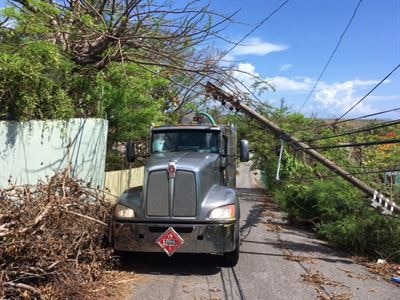By Terri Moon Cronk DoD News, Defense Media Activity
WASHINGTON, Oct. 20, 2017 — The Army Corps of Engineers is
installing up to 500 temporary generators until Puerto Rico’s old and
deteriorating power grid can be made operational again, but long-term total
power restoration could take nearly a year, the Corps’ chief of engineers told
reporters at the Pentagon today.
The Corps is starting with public facilities and it faces
power restoration to 3.4 million houses on the U.S. territory, some of which
are in remote areas, Army Lt. Gen. Todd T. Semonite said.
Semonite said the island governor’s immediate goals are to
restore power to 30 percent of Puerto Rico by the end of October and to 50
percent by the end of November, which the general said he considers a
challenge.
The Corps is responding to the effects of four major
hurricanes that struck the U.S. mainland, Puerto Rico and the U.S. Virgin
Islands within a six-week span. Puerto Rico remains a challenge in part because
it is an island, making it difficult to receive supplies, such as the 62,000
utility poles needed for power restoration.
“Puerto Rico and the Virgin Islands is a completely
different paradigm,” he said. “People have asked me in the last several weeks …
‘Why don't you do in Puerto Rico what you could have done in Florida?’ Because
it is an island and it is very, very hard to just drive hundreds of pole trucks
… down into the Virgin Islands and Puerto Rico.”
The Corps also needs about 338 utility towers, Semonite
said, noting that each one is 75 feet long and must be flown in. “And then we
need an awful a lot of connectors and cable, as well. But the whole goal is to
get the transmission up and running,” he added.
Four-fold Strategy
The Corps’ power strategy is fourfold, starting with the
temporary generators. As of today, 148 have been put in place, Semonite said.
The second line of effort is generation from the power
plants.
“We need about 2,500 megawatts of power … to be able to
restore the power back up to where it was at the beginning of the storm. Today,
right now, we've got about 21.6 percent of that up,” he said.
Transmission is the third line of effort in the strategy to
restore power, Semonite said. “The No. 1 goal right now of what the Corps is
doing is to be able to move this electricity that's in the south up to the
north,” he explained.
The fourth line of effort is distribution -- getting power
to homes and other buildings along terrain that is a massive logistics
challenge, the general said.
“There are seven large power plants that normally run off of
fossil fuel,” he said. There are also about seven solar or wind power plants
and 21 hydropower plants, Semonite added. But, the general explained, the
majority of that power is generated in the southern part of the island, while
the majority of the need is in the north -- particularly around San Juan.
Moving Power
And though transmission and distribution remain a challenge,
there just isn’t enough capacity in Puerto Rico’s existing power plants to
provide electricity to the island, Semonite said.
“Even if in fact all of the power plants are up and running,
we would have a generation shortfall,” he said. “So about a week and a half
ago, we cut a contract to a large company to come back in and place a temporary
power plant in San Juan.”
The Corps and the Defense Department are working alongside
the Federal Emergency Management Agency and Puerto Rico’s local government to
restore power to the island, he emphasized.
Restoring power to the island is going to take a massive,
long-term rebuild of the power grid, Semonite said.
“So what we are doing is to go all-out and put as many
generators in as we can, mainly in public facilities. We got a list from the
governor, and all the mayors donated to that list,” the general said. “And the
list has got about 428 different requirements on it today.”

No comments:
Post a Comment